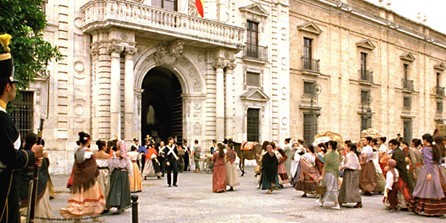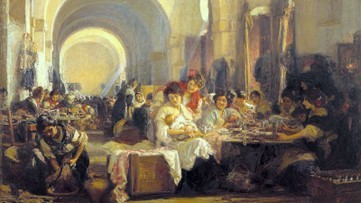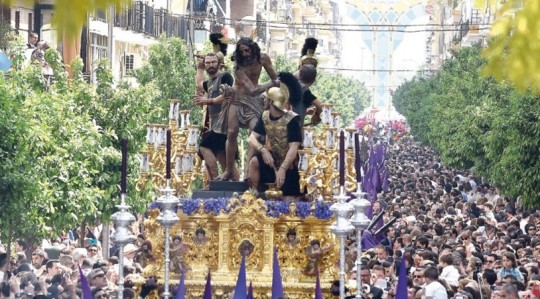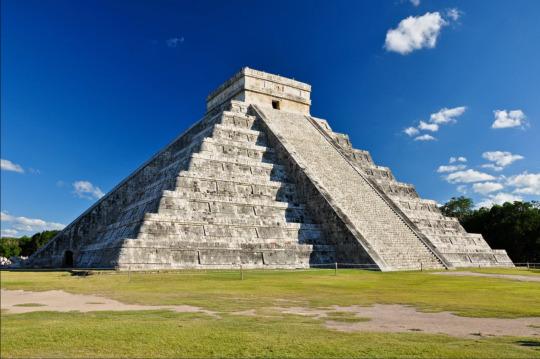#Richard Copans
Explore tagged Tumblr posts
Video
tumblr
Fernand Deligny
Extrait de Monsieur Deligny, vagabond efficace, Richard Copans - 2020 voix : Jean-Pierre Darroussin
15 notes
·
View notes
Text
LA HETERODOXA SEMANA SANTA DE LAS CIGARRERAS




ALTADIS




CIGARRERAS (GONZALO BILBAO)


En el año 2007 finalizó la relación entre Sevilla y su Fábrica de Tabacos. Una historia de más de 450 años que comenzó en la collación de San Pedro (fue la primera fábrica de tabacos de Europa y no queda ningún resto de ella); que siguió durante 200 años en la Real Fábrica de Tabacos de la calle San Fernando diseñada por el holandés Sebastián Van der Borcht y que fue orgullo de los edificios civiles españoles. Richard Ford la llamó el Escorial tabaquero ya que tan solo el Monasterio escurialense superaba en dimensiones a la fábrica tabaquera. A mediados del siglo XX la fábrica pasó al barrio de Los Remedíos con el nombre de Altadis y allí se extinguió en 2007.
La historia de la Fábrica de Tabacos de Sevilla, especialmente de los 200 años de la de la calle San Fernando está unida a la historia laboral de las mujeres y su difusión literaria y musical ha servido para darle fama universal a las “Cigarreras de Sevilla”. Pero no siempre hubo cigarreras trabajando el tabaco. Inicialmente fueron hombres los que se ocupaban de esas tareas ya que esencialmente lo que se producía era tabaco en polvo y esta elaboración requería de una fuerza física que solo estaba al alcance de los varones. Pero como en todo, las modas van cambiando y evolucionando, y el tabaco en polvo fue dejando sitio a los cigarros y cigarrillos, labor para la que las mujeres estaban más preparadas. Con los años y sobre todo en el siglo XIX, las mujeres copan la mayoría de los puestos de trabajo (entre otras razones además por sus menores exigencias laborales que los hombres). Según los datos conocidos unas 6000 mujeres llegaron a trabajar en la Fábrica de Tabacos de la calle San Fernando en la década de los años 80 del siglo XIX.
Las Cigarreras de Sevilla comenzaron a ser conocidas popularmente y la literatura se hizo eco de ellas (novela Carmen, de Prosper Merimeé). Las características a ellas atribuidas: mujeres desinhibidas y a veces muy libertinas hizo que también la música se hiciera eco de ellas (ópera Carmen, de Georges Bizet). Apareció la figura de Carmen la Cigarrera, prototipo de femme fatale, que llenaría desde entonces los teatros de ópera de toda Europa (Una aclaración necesaria: contra lo que se cree popularmente, Carmen no es andaluza sino de origen vasco navarro. Dejemos claro eso ante la tendencia a etiquetar a muchas mujeres andaluzas de esa época como sucedáneas del personaje literario).
Ciertamente la fábrica de tabacos era un gueto de mujeres en el que se comportaban de forma algo desinhibida: trabajaban en el verano escasas de ropa; de hecho, cuando algún hombre iba a entrar en la sala de trabajo de las mujeres eran advertidas para recomponer su vestimenta mediante el toque de una campana. Lógicamente esa concentración de mujeres en el siglo XIX acarreó que surgieran servicios nunca antes permitidos y nuevas reivindicaciones laborales. Así las primeras guarderías surgieron en la Fábrica de la calle San Fernando para atender a las necesidades de las madres cigarreras (en la misma fábrica existía una cárcel -edificio que permanece en pie aunque para otros menesteres- para las trabajadoras que robaban tabaco).
Con los años el colectivo de cigarreras reivindicó mejoras en sus condiciones laborales y a lo largo del siglo XIX se produjeron protestas de ese colectivo especialmente cuando se fueron incorporando las máquinas que iban a ocasionar una disminución de los puestos de trabajo (el más llamativo fue el motín de 1896).
De forma coetánea con la inauguración de la primera fábrica de tabacos se funda una hermandad que con los años será conocida como de Las Cigarreras (Jesús atado a la columna y la Virgen de la Victoria). Esta cofradía sigue saliendo la tarde del Jueves Santo sevillano desde la capilla de la última sede de la fábrica tabaquera. Las cigarreras haciendo honor a su desinhibición, en este caso verbal, tuvieron en 1915 la humorada de cantarle una saeta al nuevo cristo de la cofradía del imaginero Joaquín Bilbao y que al parecer era un bigardo de proporciones desmesuradas y que tenía semejanzas físicas con el funcionario encargado de pagar a las trabajadoras de la fábrica. La letra de la saeta no pudo ser más original:
Madre mía de la Victoria, qué penita y qué dolor, que te han quitado a tu hijo y te han puesto al pagaó.
Pero no es esta Semana Santa de 1915 la que hoy quiero recordar. Más de 20 años antes , en 1892, la cigarreras sevillanas, como forma de protesta, organizaron en la Semana Santa una especie de mascarada que terminó con disturbios. El periódico sevillano El Tribuno ofreció el relato de los hechos, pero no he podido localizar la crónica original. He acudido a una descripción que expuso en 2016 el periodista José María Rondón en su libro Semana Santa Insólita, que paso a transcribir textualmente y que no tiene desperdicio:
La Semana Santa de las cigarreras.
“Es un día cualquiera de abril de 1892. En las naves de la Fábrica de Tabacos de Sevilla se improvisa una mascarada en víspera de la salida de las cofradías. Las cigarreras dejan sus tareas y sacan de baúles, arcones y farsa de guardarropía disfraces para recrear la fiesta que en pocos días tendrá lugar en la ciudad. Es la Semana Santa de las Cigarreras.
Ya en 1835 y en 1875 habían protagonizado sus primeras huelgas y lo de ahora es un capítulo más en su leyenda de heterodoxias. Ajenas a la seriedad grave de las cofradías, las operarias improvisan una procesión de Semana Santa con Virgen, Cristo, Reina Regente y niño pelón Alfonso XIII, además de travestidas de Cánovas y Sagasta con tupé, peluca blanca y quevedos.
Los detalles de esta celebración están recogidos el 9 de abril de 1892 en El Tribuno. El cronista identifica a Carmen la Babuchera vestida con túnica y manto para recrear a la Virgen. Otra cigarrera llamada Alegría interpretaba a Cristo. Ese año, sin cruz. “Abría la marcha buen número de cigarreras vestidas de municipales y vigilantes”, narra el cronista.
Las deslenguadas cigarreras improvisaban también toda una burla a la escena política nacional. Además de las dos obreras travestidas de los políticos del turnismo de la Restauración –Cánovas y Sagasta– aparecían concejales, cónsules y hasta señores cesantes con levita y castora, como el que interpretó una cigarrera a la que apodaban La Coja.
Uno de los personajes más curiosos era el de una operaria llamada Sención, que era la Regente María Cristina, y que llevaba de la mano a su hijo en el papel del niño rey Alfonso XIII. En cada escena, no faltaba los detalles burlescos: “Llevaba la cola de la Regente una operaria vestida de maestrante”, explica la crónica de El Tribuno.
Además de la parodia nacional y procesional, las cigarreras aprovechaban para cambiar las jerarquías sociales. Cuenta el divertido relato de El Tribuno que el director de la Fábrica de Tabacos se dirigía a los talleres para que las operarias desistieran de su propósito. Desde lo alto de una mesa, una cigarrera vestida de municipal advertía que nadie “le tocaría al jefe ni un pelo de la ropa”.
Entre las blusas abiertas y los tobillos al aire el resto de operarias improvisan. Unas van vestidas con túnicas de las cofradías de “Montserrat, la O o la Macarena”. “La Velasco conducía la cera y en la confusión perdió al zagalejo. Figuraba en la procesión un lujosísimo simpecado. Vestidas de armados otras cuantas operarias, entre ellas una muy guapa llamada Esperanza”.
Naturalmente, la procesión terminó en tumulto. Fue La Coja –la que vestía de señor cesante– la que ingresó “como el año pasado, por escandalosa, en la casilla, así como otras que promovieron tumultos, carreras y sustos”. Finaliza el relato describiendo un curioso epílogo: “Hubo un hundimiento. Rompiéronse las patas de una mesa, donde estaban subidas muchas operarias. Ni el jefe ni los empleados presenciaron esta procesión”.
25/3/2023
1 note
·
View note
Photo


#amos gitai#israel#documentary#1982#1980s#war#lebanon#lebanese war#politics#arab-israeli conflict#les films d'ici#richard copans#arte
3 notes
·
View notes
Photo

Essai d'ouverture, Luc Moullet (1988)
1 note
·
View note
Photo

Fernand Deligny, vagabond efficace / Les trajets d’un enfant qui marchait en suivant son doigt sont conservés sur du calque.
#Cinéma#Fernand Deligny vagabond efficace#Richard Copans#2018#Fernand Deligny#Jean-Pierre Darroussin#Sarah Adler#Mathieu Amalric
1 note
·
View note
Photo

Coll. “Architectures” diffusée sur Arte. Par Richard Copans & Stan Neumann.
Technique : épisodes de 25 min. diffusés les dimanches à 11h15 jusqu’au 29 octobre 2017.
☼
“Proposée par Richard Copans et Stan Neumann, la collection ARCHITECTURES est aujourd'hui riche de plus de soixante films diffusés sur ARTE depuis au cours des vingt dernières années.
Chaque film traite d’un seul bâtiment choisi pour son aspect exemplaire, pour le rôle de jalon qu’il a joué ou qu’il joue dans l’évolution de l’architecture. Le bâtiment est exploré de fond en comble, décortiqué depuis les fondations jusqu’aux couvertures. Un travail sur le terrain fait apparaître des questions pratiques et simples, et la façon dont l’architecte y a répondu. Une maquette du bâtiment, réalisée spécialement pour chaque film, permet de montrer de façon claire et ludique ce qui autrement est invisible : les étapes de la conception du bâtiment, son principe constructif, l’agencement des espaces etc. Bien plus lisibles que les plans ou les croquis, ces maquettes démontables rappellent que la véritable force de la grande architecture est d’être simple comme un jeu d’enfant. Enfin, dans les films consacrés aux réalisations d’aujourd’hui, l’architecte intervient lui-même brièvement, apportant un éclairage plus subjectif en contrepoint de l’enquête du film.”
Sur Arte.tv.
☼
+ : https://sites.arte.tv/architectures/fr
0 notes
Text
Still Searching
About three years ago I finally read The God Delusion by Richard Dawkins. I’d actually read some books that countered several of his points before I got to it (Mere Christianity and The Problem of Pain by CS Lewis as well as The Case for Christ by Lee Strobel) and had decent answers for the first three chapters of material, much to my surprise. Unfortunately, his self-acclaimed chapter four was written in such a way that I was reading words that I understood individually, each by themselves, but once they joined together in a sentence I had no comprehension of the points he was trying to make. Chapter four was written in the jargon of a field so out of my frame of reference that his utter “demolishing” of God (as he claimed) blew right past me. I was chagrined, but there’s not much I can do about my lack of comprehension for his key chapter, unless I want to spend the next ten years utterly miserable as I learn everything I can about the field of study he’s supposedly an expert in.
HOWEVER. His chapter seven hit hard on my own issues with the Bible. The cruelty, the capriciousness, the truly terrible deeds and dark tales that, somehow, God seemed to be okay with. These have bothered me long before I ever read Dawkins. However, reading Dawkins prodded me to stop hiding my head in the sand and mumbling “I don’t know why” over and over. It’s prodded me to face it. For that, I can thank him.
I am far from done, partly because it took me a long time to figure out where I could even start. It was only halfway through last year that I got somewhat of a start and only late last year when I finally found a good springboard book. Here’s what I’ve gone through so far.
The Read Scripture project on Youtube. Old Testatment and New Testament. I grew up in the church and yet through this overview series, I learned all kinds of things I’d never been taught and or never clearly understood. For example, I grew up under the misconception that Israel repeatedly sinned, was taken into exile, returned, rinse & repeat. Turns out, no, there was just one major exile, and the reason I thought there was a repeat cycle was the sheer amount of prophets sent to warn Israel. I thought each one was for a different event, but it was multiple prophets to warn a divided nation of Israel/Judah. I also had no decent timeline of events offered to me. I also had no idea of some of the background context (offered lightly and as needed) as to why these books were written and what was going on etc etc etc. In short, this whole series put a lot of things in to perspective, clarified a lot, and even eased a few topics I’ve been anxious about for... ever (specifically the overview of the book of Judges and the book of Revelation did a TON for certain anxieties I had). As a bonus, it’s presented in a very easy to understand and visually engaging way.
Divorce and Remarriage in the Church by David Instone-Brewer. This might seem like a really weird book for a newlywed to pick up. I did it because a friend at the time was going through a divorce and was reading the book and I wanted to understand better. And boy, did I stumble upon a gem. I was flipping my lid every chapter, shrieking about new historical contexts for Bible passages that totally flipped current church understanding about divorce and remarriage around. Why was I flipping out? Because if there was that much compelling evidence that we got context wrong about THIS topic, WHAT OTHER TOPICS do we desperately need context on? This book was a mini-discourse on why reading the Bible with the perspective of first century readers is vital. This was my springboard book. Since I found this, I’ve had a slightly better idea of the sort of book/resource I’m looking for.
Is God a Moral Monster? by Paul Copan. Honestly this one pissed me off pretty badly. While some chapters thoroughly answered my concerns about SOME of the Old Testament topics he touched on, other chapters strained reason too far. My main complaints were when he reached hard for the most favorable interpretation, when he pre-supposed the validity of his argumentative stepping stones (instead of making sure they were firm for the reader before moving on. I got spoiled by the style of Lee Strobel and CS Lewis), and when he repeatedly mocked New Atheists. All this has permanently soured me on this author and I don’t want to read or listen to anything by him in the future.
Lectures by Bart Ehrman. This is the latest, and my husband and I are slowly watching our way through one of his lecture series. Bart Ehrman is an Agnostic who lectures about the context of early Christianity and the context and historicity of the New Testament. Some of the points he makes leave me shaken and with a lot of questions (and in one case, wanting to cross out Mark 16:9-20 from my Bible entirely) but in other cases what he has to say clicks into place, making sense of things I’d glossed over my whole life.
“Just pray and read the Bible,” is a thing I’ve been told by well meaning people, but aside from the fact that standard translations have never been clear to me in any kind of self-contained way, I’m coming to believe more and more that people get some really nasty misunderstandings and unsanctioned verbal weaponry without understanding the context of each part of the Bible. And while each person’s walk with God is different, and while "just pray and read the Bible” may legitimately be enough for some people to have a strong walk with God, I never want to hear it aimed at me again. Because it WASN’T enough growing up and it STILL ISN’T. I need to know more. And scared as I am about my suppositions being challenged, the truth matters.
5 notes
·
View notes
Photo

SUEDE anuncian tercer anticipo "THAT BOY ON THE STAGE", quince días antes de la salida de su nuevo álbum 'AUTOFICTION'
Suede lanza “That Boy On The Stage”, tercer single extraída de su próximo álbum de estudio, ‘Autofiction’, que saldrá el 16 de Septiembre a través de BMG.
“That Boy On The Stage” tiene todos los elementos para convertirse en una canción himno de Suede. La canción ve a Brett Anderson teniendo una visión externa de la personalidad que adopta en sus conciertos de Suede. "Habla de personalidad", dice Brett. "Sobre las personas en las que nos transformamos cuando subimos a un escenario".
“That Boy On The Stage” es el tercer adelanto del nuevo disco ‘Autofiction’ de Suede antes escuchamos “She Still Leads Me On” y “15 Again”. Estos temas ya copan las listas de musicales de las radios y las playlist en todos los países. Según The Times estamos ante "un álbum nuevo soberbio", "Suede acaba de hacer su mejor álbum desde hace décadas" comenta Uncut, "…muy conmovedor, una fuerza Punk que preserva un núcleo profundamente vulnerable…" escribe la revista MOJO y "esencial e actual" se puede leer en la revista AnOther.
youtube
SUEDE – ‘AUTOFICTION’
Cuando Suede comenzó a trabajar en las canciones que se convertirían en ‘Autofiction’, decidieron volver a lo básico. En un movimiento que recordó sus primeros días como banda, Brett Anderson, Mat Osman, Simon Gilbert, Richard Oakes y Neil Codling se encerraron en unos locales abandonados en Kings Cross, abrieron la puerta, llevaron sus instrumentos, montaron todo su equipo y comenzaron a tocar juntos.
‘Autofiction’ se grabó como si fuera en directo (todos tocando juntos) en los Konk Studios en el norte de Londres con el afamado productor Ed Buller, colaborador de Suede durante sus inicios. Ed trabajó por primera vez con la banda produciendo su primer single ”The Drowners”, que cumple 30 años de su edición, este mes. Si hace 30 años ”The Drowners” fue un himno generacional que habla de una juventud perturbada, borrosa e inusual, entonces la fuerza de ‘Autofiction’ con las preocupaciones de un punto diferente en la vida, suena aún más vital.
Y donde Suede quiere estar es, en cierto modo, el mismo lugar en el que estaban cuando comenzaron hace 30 años: un grupo de personas que viven de la cruda sensación de crear música juntos, en una habitación.
Sobre ‘Autoficción’, Brett Anderson, su vocalista, lo describe así:
"’Autofiction’ es nuestro disco Punk!. Sin silbidos, ni campanitas. Solo nosotros cinco en una habitación con todos los fallos y errores; la banda expuesta en todo su desorden primario".
Suede 2022: Foto de Dean Chalkley
SUEDE – ‘AUTOFICTION’
Tracklisting:
1. She Still Leads Me On
2. Personality Disorder
3. 15 Again
4. The Only Way I Can Love You
5. That Boy on the Stage
6. Drive Myself Home
7. Black Ice
8. Shadow Self
9. It’s Always the Quiet Ones
10. What am I Without You?
11. Turn off Your Brain and Yell
PreOrder aquí: https://suede.lnk.to/autofictionPR
A LA VENTA EL 16 DE SEPTIEMBRE 2022
0 notes
Text
0 notes
Text


Monsieur Deligny, vagabond efficace - Richard Copans (2020)
14 notes
·
View notes
Link
very good video by Richard Copans about the building.....music heard in the end is “Metastasis”, by Iannis Xenakis, the young architect in Corbusier’s office who designed the rhythm of vertical mullions at the large openings - the ‘undulatory panels’.
_ik
1 note
·
View note
Photo

#claire simon#1998#1990s#documentary#school#childhood#france#richard copans#les films d'ici#arte#sophie dulac
0 notes
Link
The Maya refer to both a modern-day people who can be found all over the world as well as their ancestors who built an ancient civilization that stretched throughout much of Central America, one that reached its peak during the first millennium A.D.
The Maya civilization was never unified; rather, it consisted of numerous small states, ruled by kings, each apparently centered on a city. Sometimes, a stronger Maya state would dominate a weaker state and be able to exact tribute and labor from it.
Mayan calendar
A system of writing using glyptic symbols was developed and was inscribed on buildings, stele, artifacts and books (also called codices).
The Maya calendar system was complicated. "By some 1,700 years ago speakers of proto-Ch'olan, the ancestor for three Maya languages still in use, had developed a calendar of 18 20-day months plus a set of five days," wrote Weldon Lamb, a researcher at New Mexico State University, in his book "The Maya Calendar: A Book of Months" (University of Oklahoma Press, 2017).
This calendar system also included what scholars call a "long-count" that kept track of time by using different units that range in length from a single day to millions of years (the unit in millions was rarely used).
Contrary to popular belief, this system did not predict the end of the world in 2012, the unit in millions of years providing evidence of this.
Also, contrary to popular belief, the Maya civilization never vanished. While many cities were abandoned around 1,100 years ago, other cities, such as Chichén Itzá, grew in their place.
When the Spanish arrived in Central America in force in the 16th century, the diseases they brought devastated the Maya. Additionally, the Spanish forced the Maya to convert to Christianity, going so far as to burn their books (the reason why so few of them survive today). However, it is important to note that the Maya people live on today and can be found all over the world.
"Millions of Maya people live in Central America and throughout the world. The Maya are not a single entity, a single community, or a single ethnic group. They speak many languages including Mayan languages (Yucatec, Quiche, Kekchi and Mopan), Spanish and English. However, the Maya are an indigenous group tied both to their distant past as well as to events of the last several hundred years," wrote Richard Leventhal, Carlos Chan Espinosa and Cristina Coc in the April 2012 edition of Expedition magazine.
Maya origins
While hunters and gatherers had a presence in Central America stretching back thousands of years, it was in what archaeologists call the Pre-classic period (1800 B.C. to A.D. 250) that permanent village life really took off, leading to the creation of early Maya cities.
"Really effective farming, in the sense that densely inhabited villages were to be found throughout the Maya area, was an innovation of the Pre-classic period," wrote Yale University Professor Michael Coe in his book "The Maya" (Thames and Hudson, 2011).
Coe said farming became more effective during this period, likely because of the breeding of more productive forms of maize and, perhaps more importantly, the introduction of the "nixtamal" process. In this process, the maize is soaked in lime, or something similar, and cooked, something that "enormously increased the nutritional value of corn," writes Coe. Maize complemented squash, bean, chili pepper and manioc (or cassava), which were already being used by the Maya, a 2014 Journal of Archaeological Science study shows.
During this time, the Maya were influenced by a civilization to the west of them known as the Olmecs. These people may have initially devised the long count calendar that the Maya would become famous for, Coe writes. Additionally, the discovery of a ceremonial site dated to 1000 B.C. at the site of Ceibal sheds more light on the relationship between the Maya and Olmecs, suggesting that it was a complex one.
Archaeologists have found that early Maya cities could be carefully planned. Nixtun-Ch'ich, in Peten, Guatemala, had pyramids, temples and other structures built using a grid system, a sign of urban planning. It flourished between 600 B.C. and 300 B.C.
Maya civilization at its peak
Coe writes that the ancient Maya reached a peak between A.D. 250 and 900, a time that archaeologists call the "Classic" period when numerous Maya cities flourished throughout much of Central America.
The civilization "reached intellectual and artistic heights which no other in the New World, and few in Europe, could match at the time," Coe writes. "Large populations, a flourishing economy, and widespread trade were typical of the Classic …" he said, noting that warfare was also quite common.
The Maya civilization was influenced by the city of Teotihuacan, located farther to the west. One of their early rulers, named Siyaj K'ak, who may have come from Tikal, ascended the throne on Sept. 13, A.D. 379, according to an inscription. He is depicted wearing feathers and shells and holding an atlatl (spear-thrower), features associated with Teotihuacan, wrote researcher John Montgomery in his book "Tikal: An Illustrated History of the Mayan Capital" (Hippocrene Books, 2001). A stela recently discovered at El Achiotal, a site near Tikal, also supports the idea that Teotihuacan controlled or heavily influenced Tikal for a time.
The numerous cities found throughout the Maya world each had their own individual wonders that made them unique. Tikal, for instance, is known for its pyramid building. Starting at least as early as A.D. 672, the city's rulers would construct a twin pyramid complex at the end of every K'atun (20-year period). Each of these pyramids would be flat-topped, built adjacent to each other and contain a staircase on each side. Between the pyramids was a plaza that had structures laid out to the north and south.
Copan, a Maya city in modern-day Honduras, is known for its "Temple of the Hieroglyphic Stairway." It's a pyramid-like structure that has more than 2,000 glyphs embellished on a flight of 63 steps, the longest ancient Maya inscription known to exist and appears to tell the history of the city's rulers.
The site of Palenque, another famous Maya city, is known for its soft limestone sculpture and the incredible burial of "Pakal," one of its kings, deep inside a pyramid. When Pakal died at about age 80, he was buried along with five or six human sacrifices in a jade-filled tomb (including a jade funerary mask he wore). His sarcophagus shows the king's rebirth and depictions of his ancestors in the form of plants. The tomb was re-discovered in 1952 and is "the American equivalent, if there is one, to King Tut's tomb," said archaeologist David Stuart in an online National Geographic lecture.
Not all Maya settlements were controlled by a king or elite member of society. At Ceren, a Maya village in El Salvador that was buried by a volcanic eruption 1,400 years ago, archaeologists found that there was no elite class in control and the village seems to have been managed communally, perhaps by local elders.
Collapse?
Contrary to popular belief the Maya civilization did not vanish. It's true that many cities, including Tikal, Copan and Palenque, became abandoned around 1,100 years ago. Drought, deforestation, war and climate change have all been suggested as potential causes of this. Drought may have played a particularly important role as a recent study on minerals from an underwater cave in Belize shows that a drought ravaged parts of Central America between A.D. 800 and 900.
However, it is important to note that other Maya cities, such as Chichén Itzá, grew, at least for a time. In fact, Chichén Itzá has the largest ball court in the Americas, being longer than a modern-day American football field. The court's rings, through which competing teams tried to score, rose about 20 feet (6 meters) off the ground, about twice the height of a modern-day NBA net. The rules for the Maya ball game are not well understood.
Council Houses, which were gathering places for people in a community, played an important role in some of the Maya towns and cities that flourished after the ninth century.
As mentioned earlier, the arrival of the Spanish brought about a profound change in the Maya world. The diseases they brought decimated the Maya and the Spaniards forced the Maya to convert to Christianity, even burning their books. Today, despite the devastation they experienced, the Maya people live on, numbering in the millions.
Mythical origins
The Maya had a lengthy and complicated mythical origin story that is recorded by the K'iche Maya (based in Guatemala) in the Popol Vuh, the "Book of Counsel," wrote Coe in his book. According to the stories, the forefather gods Tepew and Q'ukumatz "brought forth the earth from a watery void, and endowed it with animals and plants."
Creating sentient beings proved more difficult, but eventually humans were created, including the hero twins, Hunahpu and Xbalanque, who embark in a series of adventures, which included defeating the lords of the underworld. Their journey climaxed with the resurrection of their father, the maize god. "It seems clear that this whole mythic cycle was closely related to maize fertility," Coe writes.
The Maya universe
The late Robert Sharer, who was a professor at the University of Pennsylvania, noted in his book "Daily Life in Maya Civilization" (Greenwood Press, 2009) that the ancient Maya believed that everything "was imbued in different degrees with an unseen power or sacred quality," call k'uh, which meant "divine or sacredness."
"The universe of the ancient Maya was composed of kab, or Earth (the visible domain of the Maya people), kan, or the sky above (the invisible realm of celestial deities), and xibalba, or the watery underworld below (the invisible realm of the underworld deities)," Sharer wrote.
Caves played a special role in Maya religion as they were seen as entranceways to the underworld. "These were especially sacred and dangerous places where the dead were buried and special rituals for the ancestors conducted," wrote Sharer.
Sharer notes that the Maya followed a number of deities, the most central of which was Itzamnaaj. "In his various aspects, Itzamnaaj was the lord over the most fundamental opposing forces in the universe — life and death, day and night, sky and earth," Sharer wrote, noting that "as lord of the celestial realm" Itzamnaaj was the Milky Way and could be depicted as a serpent or two-headed reptile.
Other Maya deities included the sun god K'inich Ajaw, the rain and storm god Chaak and the lightning deity K'awiil, among many others. The Maya believed that each person had a "life force," and draining a person's blood in a temple could provide some of this life force to a god. Recently an arrowhead containing the blood of a person who may have participated in a blood-letting ceremony was identified.
In times when water was scarce, Maya kings and priests would hold incense scattering ceremonies that they believed could provide wind and rain. A Maya pendant inscribed with 30 hieroglyphs that archaeologists believe would have been used in these ceremonies was recently discovered in Belize. Hallucinogenic substances could also be used to help the Maya contact spirits and seek advice on how to deal with problems or situations.
Maya religion also included stories of dangerous creatures such as the sea monster "Sipak." Fossilized teeth from the extinct shark Carcharodon megalodon were used as sacred offerings at several Maya sites and recent research suggests that stories involving "Sipak" were inspired by the fossilized remains of this massive extinct shark.

El Castillo is a pyramid with 91 steps on each of its four sides.
Credit: jgorzynik shutterstock
Human sacrifices
Sharer wrote that human sacrifices were made on special occasions. "Among the Maya, human sacrifice was not an everyday event but was essential to sanctify certain rituals, such as the inauguration of a new ruler, the designation of a new heir to the throne, or the dedication of an important new temple or ball court." The victims were often prisoners of war, he noted.
At Chichén Itzá, victims would be painted blue, a color that appears to have honored the god Chaak, and cast into a well. Additionally, near the site's ball court, there is a panel that shows a person being sacrificed. This may depict a ball-player from either the winning or losing team being killed after a game.
Writing & astronomy
Sharer noted that record keeping was an important part of the Maya world and was essential for agriculture, astronomy and prophecy. "By keeping records of the rainy and dry seasons, the Maya could determine the best times to plant and harvest their crops," Sharer wrote.
Additionally, by "recording the movements of the sky deities (sun, moon, planets, and stars), they developed accurate calendars that could be used for prophecy," Sharer wrote.
"With long-term records, the Maya were able to predict planetary cycles — the phases of the moon and Venus, even eclipses," he said. "This knowledge was used to determine when these deities would be in favorable positions for a variety of activities such as holding ceremonies, inaugurating kings, starting trading expeditions, or conducting wars."
The movements of the planet Venus appear to have played a particularly important role in Maya religion. Both the Dresden and Groliercodices contain detailed records of the movements of the planet. The ancient Maya "were probably doing large-scale ritual activity connected to the different phases of Venus," said Gerardo Aldana, a science historian in the department of Chicano studies at the University of California, Santa Barbara.
Recent research reveals that at least some of the writers of Maya codices were part of "a specific cohort of ritual specialists called taaj," wrote a team of researchers in a 2015 American Anthropologist article. The team studied a room containing murals with inscriptions on them at the site of Xultun, Guatemala, and found that the writing of codices took place in the room and that the "taaj" wrote them.
Economy & power
Sharer wrote that while agriculture and food gathering were a central part of daily life, the Maya had a sophisticated economy capable of supporting specialists and a system of merchants and trade routes. While the Maya did not develop minted currency, they used various objects, at different times, as "money." These included greenstone beads, cacao beans and copper bells.
"Ultimately, the power of kings depended on their ability to control resources," Sharer wrote. "Maya rulers managed the production and distribution of status goods used to enhance their prestige and power. They also controlled some critical (non-local) commodities that included critical everyday resources each family needed, like salt," he said noting that over time Maya rulers managed ever-larger portions of the economy. The Maya rulers did not rule alone but were served by attendants and advisers who occasionally appear in Maya art.
Sharer also notes that Maya laborers were subject to a labor tax to build palaces, temples and public works. A ruler successful in war could control more laborers and exact tribute on defeated enemies, further increasing their economic might.
#archaeology#arqueologia#mesoamerica#maya#mexico#yucatan#guatemala#belize#history#historia#greenstone#jadeite#copper#cacao#cobre#tikal#chichen itza#calakmul#copan#honduras#teotihuacan
72 notes
·
View notes
Text
French cinema seeks a parade
[ad_1]


Excerpt from Richard Copans’ documentary, “Monsieur Deligny, vagabond effective”, directly released on video-on-demand. SHELLAC DISTRIBUTION
Save the movies: as theaters have been closed since Saturday March 14 due to the epidemic of Covid-19, the whole of the cinema industry is at the same time stunned and teeming with ideas. On the distributors’ side, the question arises of the flow…
View On WordPress
0 notes
Text
Dans le film que Richard Copans a fait sur Deligny (Monsieur Deligny, le vagabond efficace), une femme fait entendre la voix de Josée Manenti.
Josée, impliquée dans La grande cordée depuis ses débuts, a investit un héritage pour acheter une caméra et de la pellicule. C’est elle qui filme Le moindre geste.
Elle dit :
« Comme souvent avec Deligny, c’est d’abord la réalisation de l’idée pratique qui comptait, assez peu le produit final... Le produit final c’était sa réflexion et le travail avec Yves. Une fois que le tournage avait été vécu, l’idée perdait de son sens. Si Deligny s’int��ressait au cinéma du moment du Moindre geste, c’était moins pour faire un film que pour mettre Yves en situation... Et encore! C’est moi qui le formule à sa place. Deligny en parlait à peine. Il disait simplement
« On va faire un film ».
C’était un objet commun pour une petite bande de gens. Une manière de nous mobiliser et régler la vie quotidienne. Le film faisait loi ».
On la voit sur ces deux photos. Sur la première elle me fait penser à Chantal Akerman.


Le tournage se fait à Veyrac entre 1962 et 1964.
0 notes
